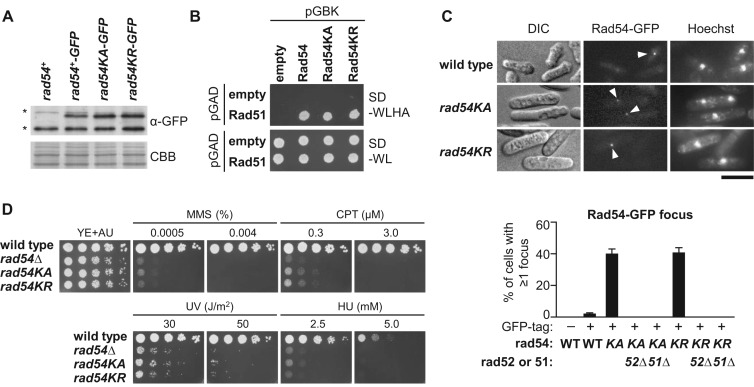Figure 3.
rad54KA and rad54KR accumulate cells containing Rad54 foci and cause hypersensitivity to DNA damage and replication stress. (A) Immunostaining of Rad54-GFP. Extracts were prepared from rad54+, rad54+-GFP, rad54KA-GFP and rad54KR-GFP cells (TNF3864, 3945, 4465 and 4489, respectively). CBB, Coomassie Brilliant Blue. Asterisks indicate non-specific bands. (B) Yeast two-hybrid interaction between Rad51 and Rad54. Budding yeast AH109 was transformed with pGBKT7 or its derivatives expressing Rad54, Rad54KA or Rad54KR (pTN997, 1005 or 1004, respectively), in combination with pGADT7 or its derivative expressing Rad51 (pTN998). Transformants grown in SD-WL media were spotted onto SD-WLHA and SD-WL plates, and incubated at 30°C for 3 days. (C) Rad54-GFP focus formation. Arrowheads indicate Rad54-GFP foci. Scale bar indicates 5 μm. Percentages of the cells containing at least one Rad54-GFP focus in rad54+, rad54+-GFP, rad54KA-GFP, rad54KA-GFP rad52Δ, rad54KA-GFP rad51Δ, rad54KR-GFP, rad54KR-GFP rad52Δ and rad54KR-GFP rad51Δ strains (TNF3864, 3945, 4465, 4410, 4409, 4489, 4413 and 4412, respectively) are shown. More than 200 cells were examined by fluorescence microscopy in each measurement. DIC, differential interference contrast. WT, wild-type. n = 3, mean ± s.d. (D) Sensitivity to DNA damage and replication stress. Exponentially growing cells of wild-type, rad54Δ, rad54KA and rad54KR strains (TNF672, 4491, 4144 and 4143, respectively) were 5-fold serially diluted with distilled water and spotted onto YE+UA supplemented with methanesulfonate (MMS), camptothecin (CPT) or hydroxyurea (HU) at the indicated concentrations. The plates were UV-irradiated with indicated doses and incubated at 30°C.

